-
Paper Information
- Paper Submission
-
Journal Information
- About This Journal
- Editorial Board
- Current Issue
- Archive
- Author Guidelines
- Contact Us
International Journal of Arts
p-ISSN: 2168-4995 e-ISSN: 2168-5002
2014; 4(1): 8-16
doi:10.5923/j.arts.20140401.02
Theosophical Principles of Light and Colour in the Architecture and Decorations of Soltaniyeh Dome
Robab Faghfoori1, Hasan Bolkhari Ghehi2, Ghazal Soltani3
1College of Art and Architecture, Imam Reza International University, Mashhad, Iran
2Associate Professor of University of Tehran
3MA in Architecture, college of Art and Architecture, Zanjan University, Zanjan, Iran
Correspondence to: Robab Faghfoori, College of Art and Architecture, Imam Reza International University, Mashhad, Iran.
| Email: |  |
Copyright © 2014 Scientific & Academic Publishing. All Rights Reserved.
With deliberation on the architecture of Iran in Islamic period, it can be said that spaces and decorations used in its buildings have a deep relationship with cultural beliefs and world-view of Islam. Although, it is assumed in the first look that the space of these works have been shaped according to local and climatic conditions of Iran, but with more profound look, it can be observed that they are at the result of the spiritual and wise attitudes of the artists who have created their works by concerning to these principles. The authors of this paper intend to introduce the architectural and decorative arrays used in the soltaniyeh dome, and investigate the theosophical principles of light and colour, also analysis their symbolic meanings in this masterpiece of art and architecture in Ilkhani era. Research findings show that the use of light and arrays reflected it, as well as a variety of special colours, such as blue and green in this tomb are rooted in the religious beliefs of its founders and to make manifest the concepts as divine presence, transcendent unity, and determinations which are derived from plurality. Methods used in this research are descriptive, analytical and interpretive. The approach to data has been done through library studying and building visiting.
Keywords: Islamic architecture, Soltaniyeh dome, Symbolic meanings, Light and colour
Cite this paper: Robab Faghfoori, Hasan Bolkhari Ghehi, Ghazal Soltani, Theosophical Principles of Light and Colour in the Architecture and Decorations of Soltaniyeh Dome, International Journal of Arts, Vol. 4 No. 1, 2014, pp. 8-16. doi: 10.5923/j.arts.20140401.02.
Article Outline
1. Introduction
- Islamic architecture has been derived from Islamic religious that its root has been made by confident belief of spiritual and wise rules. On the other hand, Islam is introverted school and accordingly, The Arts emanating from the Islamic ideas and world-view have a symbolic forms and meanings. Therefore, the Muslim artist attempts to provide those aspects in the aesthetic, conceptual and mysterious method with his inner vision. Symbolic meanings are the essence of the truth in the aspects which clarify those meanings and secrets in front of the eyes of audiences in this era [1]. Basically, the entity of symbols (in Islamic art) obey of this reverse bias that inferiors show the superiors which means this world does not reveal only its face but also manifests the spiritualism [2]. In all religious arts including Islamic architecture, there is symbolic aspect which cites that the world is the shadow of a truth and transcendent order and the symbols are the expression of the transcendent reality and the spiritual truth [3]. As in the Quran and other religious books, it has been spoken by secret and sign language for the expression of spiritual facts. The assumption of this research is based on this fundamental notion that there is an essential link between art and philosophy and the application of architecture and special colours inside the mosques and domes, arabesque decoration, calligraphy, the art of writing verses (inscription), woodcarving, painting and etc. Islamic civilization is the consequences of art composition with spirituality, philosophy and religious emotions of their artists and their establishers. In other words, these elements and the decorations are preferred according to symbolic meanings, dynamic sense and religious choice of people. In this case, there is no any dominance of spontaneous and contractual aspects on them. As in Islamic architecture, “innate and permanent qualities of dome should be recognized as a minor manifestation of the major dome of planetarium which is heaven; the qualities which are assorted and they are the sign of a great spirit that encompass the universe; the first source which all creatures are come from” [2].After the advent of Islam in Iran architecture, many domes and monuments are constructed in addition of mosques. Among the historic buildings, it can be pointed to soltaniyeh dome which its exploration and the clarification of its decorative arrays are the most important tools for recalling the spiritual and noetic foundations of the architecture of this land and they are also acknowledgement for the idealist and cultural beliefs of dominators of that era. This massive building has been built in the Ilkhani period with order of Sultan Mohammad Khodabande and by Ali Shah who was this great building's architect between the years of 703-713AH (1304-1314AD) [4] in Iran-Zanjan and the purpose of its construction was for the transportation of the first and third Imam bodies of Shia from Iraq to this place. This event was opposed by Najafian religious authorities and according to some historical texts and documents became a mausoleum for Sultan Mohammad Khodabande himself. Although Etemad-al-Saltaneh has rejected the recent point in Merat al-Boldan and has quoted this building only as Jame mosque in that time. The inclination of Sultan Mohammad (Oljato) to Islam religion caused its propagation across the country and provided doctrinal and cultural methods that shaped the art which had been imported from East Asia by Mongol governors in the form of Iran-Islamic concepts with the base of traditions and indigenous experiences of Iran [5]. The architecture and decoration of soltaniyeh dome is no exception of this momentous matter and its decorations have been shaped as a building to be a tomb or a mosque. Like such buildings, soltaniyeh building has also a very strong spiritual point of view, the point that should be concerned as a default on our analysis and interpretations of light and color in this ancient building.This study is declared to achieve the religious and mystical principles of the light and color which are the two important elements for the explanation of symbolic meanings in the form of architecture and decoration and the necessity of this aim is to identify certain attitudes which have been in this historical place and has been covered to us up to this time. In scrutiny that have been done through this case, there was not extensive research in corresponding to this topic and the recent studies are about the introduction of this old place and the explanation of soltaniyeh dome's architecture and decoration have been completed solely in description way without attention to its theoretical foundations. The main question of this research is about the principles and implications of light and color in Islamic architecture and the presence of these two elements in soltaniyeh dome and the amount of its capability to illustrate the spiritual values, the message of its founders and the dominant essence in the body of this huge building. In order to attain this aim, the visiting of this building has been done and images in different types have been taken, then by using library studying, the main theosophical principles of light and color and the decorations of this ancient building were studied by description, analysis and interpretation approaches.
2. The Thought of Light and Color in Islamic Philosophy and Architecture
- The presence of light in the works of Iran's architecture is so momentous especially after the advent of Islam. This essential element has been considered as a practical factor which is the reason for lighting and daily activities of life and also as an important role in beliefs. Light by the term of sages is a simplicity truth which is appearance innately itself and makes the other things clear and luminous [6]. The light has had a major role in Iranian's thoughts before and after the advent of Islam. In the philosophy of ancient Persia, God (Ahura Mazda) is the same as Allah in Islam and matches to light. After the tendency of Iranians to Islam, the manifestations of Zoroastrianism did not disappear and because of acquaintance of Iranians with its mystical concepts, the Zoroastrianism mixed with Islam. Light as a sacred element before the Islam has been paid attention and many of these concepts were revived seriously and specially by the endeavor of Shahab al-Din Suhrawardi. Aside from interesting comments of Suhrawardi and some other Islamic philosophers like Avicenna or Al-Ghazal about the interpretation of light verse, theosophists such as Najmuddin Kubra, Sheikh Mohammad Lahiji, Alaodole Semnani and Najm Razi have offered valuable researches and ideas on light and colour issues. In the thoughts of Quran and Islamic philosophers “God is the lighter of the heavens and the earth” [7] and where there is light, God will be presented. Hence, the light is a symbol of the unity and absolute aspect of divine. Islamic thought submits God as inherent truth of all creatures in the theory of oneness. The uniqueness of internal reality in relation with many varied manifestations which is compared by referring to natural phenomenon such as colourless and invisible light with visible and coloured despondencies of that. This concept is stated by many verses of Quran: “Whichever way you turn, there is the face of allah. He is the embracer, the knower”. [7] So, light has been descripted as God who can make everything to be visible and meaningful [8].Titus Burkhart accepts the light as the intrinsic parts of the art and he believes that the idea of oneness can be possible via the artist by three elements: “the first one is geometry which shows the unity in space order; the second one is rhythm which displays the unity in worldly arrangement directly and in space indirectly. The last one is the ratio of light to visible forms which is the same as the ratio of absolute existence to limited creatures.” [9] Those three definitions which have been concerned by the Islamic artists especially in the area of mosques architecture and religious places and by regarding them, they have created spaces which are the reflection of God's life and presence. Using windows and multiple holes in these spaces provide physical area for the better existence of light in better condition which the spiritual aspect of light will be supported too. Iranians art of mirrors and utilization of mosaics and having bright and turquoise colors for domes and the decoration of Muqarnases, Shamsehes and engravings are the other zones for manifestation of light in Islamic architecture [10]. The sacred architectural space is made essentially in a way to induce the presence of God and its divine sense, so each individual believer will see himself/herself surrounded by this presence: “Allah encompasses them all from behind” [7]The second essential element of art and Islamic architecture is color. Color in science topics has been considered in two aspects; the one in physic and the other one is in metaphysic and religious-mystical texts. The first topic can be analyzed in material world and the second topic can be analyzed in spiritual world. Color in the realm of matter has been obtained from the refraction of light and various colors become apparent by contact of light with objects in different wavelengths, but in the second case, color is the cause of spiritual appearance which in the realm of mysticism is used as a distinguishing factor in spiritual journey. Mystics don’t talk about colors as the light refraction; in fact they believe it as the factor of appearance. In other words, single light and the light with no-material quality can be signified by means of color and will be a factor for visibility and a place for the observation of spirituality. In Islamic philosophy, light is a manifestation of divine harmony and when the light of harmony changes to multiplicity of creatures and the world is being formed; this is the color which poses the differences of various expressions and appearances. Colors are the mirror of existent world and according to the philosopher's beliefs of Islamic art, if we know the light in it's not refraction style as the symbol of unity; the color also can be the definition of multiplicity [11]. In other words, the transcendent, single and colorless nature of light which is the complete symbol of unity is embodied with color and it is the colorful expression of discoloration [12]. The demonstration of this incorporation has been cited by Jalāl ad-Dīn Mohammad Balkhī, (Mawlānā): "It is surprise that colour which comes from colourless, afterwards the colour initiates confliction with colourless" [13].Each color has three aspects or three visual traits which are changeable independently. These three aspects are: hue, brightness and saturation. The hue can be defined as the general name of colors. Colors which include hue are green, yellow, blue, red and etc. Colors without hue include white, black and gray that are not identified as colors scientifically [14].
3. The Architecture and Decorations of Soltaniyeh Dome
- Iranians have presented purest samples to the art world by pursuit of the arts which have been shown based on the foundations of Islamic world-view. soltaniyeh dome is one obvious example of this octagonal building with a hemispherical dome by the height of 54 meters and 25 meters in diameter has eight minarets with turquoise and azure coverage of tiles in the style of Khofte-bidar that have been added the beauty and strength to this building. (Picture 1) There is a vestibule below the minarets which has surrounded the around of the building and its arched roofs are covered by elegant brick work with plastery cover on it [15]. The roofs of western, northwestern, eastern and northeastern of porches have been decorated by star-shaped motifs which the name of Allah has been written by Sols’ scripts. This building by using white, buff and ochre colors and embedding the colorful designs have exposed a masterpiece of combining color with brick and plaster. This vestibule which is the roof of building and is considered as a base for the dome is leaded to the second floor via spiral staircase that in the second floor there is a corridor around the building which consists of rooms that are dominant to the main space of the building from inside. In each building's side, three rooms of all rooms are opening to outside and small and large skylights in northern, western and eastern porches manifest the beauty of sky and nature in addition of light reflections inside of the building. This part of the building comprises of beautiful decoration such as tiling, plastering, Muqarnas, combining of tile and brick and inscriptions that are considered as “calligraphy of art innovations in Islamic architecture of Iran” [16]. Eight sides of the building appear as eight balconies in ground floor (four large balconies and four small balconies) which are a mention of heaven's eight doors (sacred ones); the doors of the building involve of three floors and three parts by the names of (Ghonbad khane, Torbat khane, Sardabe) [17]. Sheila Bair describes the interior side of soltaniyeh dome in this attitude: “the tallest internal part of soltaniyeh building which is one of the biggest continuous spaces in Middle Ages with glorious exterior cause the wonder and admiration of every viewer. The majesty and the elegance of soltaniyeh's building has anecdote of its capable designers who could realize the passion of Sultan Mohammad Khodabande for the splendor and complexity of soltaniyeh.”[18] The interior walls of the building have decoration of scrolls, margins of tangled flowers and stars made by tiles and bricks through two periods. The main four walls of the building with the design of intersecting polygons and pentapetalous stars that have been decorated with tiles and plasters and the other four walls have been decorated by patches of blue tiles and light brown bricks. This tomb has been built in no imitation of any building and is the only invention for the construction of a building with magnificent decorations and is a representation of tiling industry at high degree in Ilkhani era. [19] There are many elements in the architecture and decoration of this huge building which have created a unique balance in achievement of religious and spiritual transcendences. Then the analysis of symbolic meanings and principles of two light and color elements will be done.
 | Picture 1. Dome of Soltaniyeh |
3.1. The Manifestation of Light in Soltaniyeh Dome
- Due to the sunlight exposure in most parts of the Iran, the necessity of light in biological environments has been the integral part of the life throughout the history [20] that in most parts of Iran architectural spaces, the combination of elements in both horizontal and vertical axes is seen. The action of vertical line is set generally in open spaces toward the sky and light till the immediate link between architecture, light and sky will be occurred as a visual result in external and internal sides of building's body. One of the best examples of this valuable link and light reflection to inside of the building can be seen in soltaniyeh octagonal dome (Picture 2).
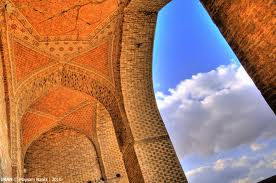 | Picture 2. Relation between architecture, light and sky in soltaniyeh Dome |
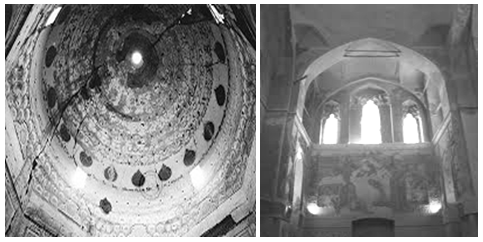 | Picture 3. Skylights on the building of Soltaniyeh |
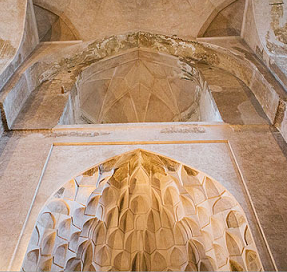 | Picture 4. Muqarnas as a decorative device in soltaniyeh Dome |
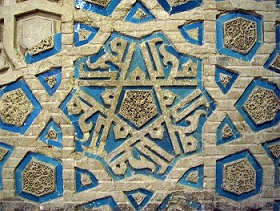 | Picture 5. Shamseh by means of sun and the light of Mohammad  |

 | Picture 6. Shamseh by means of sun and the light of Ali  |
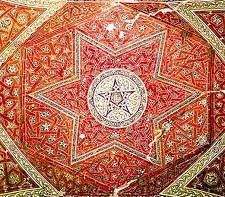 | Picture 7. The shape of star and its light |
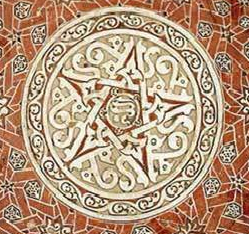 | Picture 8. The light of God  reflected from the star of Mohammad reflected from the star of Mohammad |
3.2. Expression of Colour in Decoration of Soltaniyeh Dome
- The widespread and variety usage of colours in this building has done the creation of spiritual space successfully. The usage of brilliant colours is the manifestation of traditional architecture which shows sublime truth of God aspect. The artist brings signs of God for the people of faith by performing those mentioned above: “and what he has multiplied for you in the earth is of various hues; surely, in that there is a sign for a nation who remember” [7]. Here, colour as a derived from of light concludes esoteric concept of unity in diversity. Rich and bright colours have combined in perfect balance and have made a unique appearance to the body of building. According to Andre Godard “the colours which have been used in decoration of soltaniyeh were unprecedented in the terms of frequency and concentration up to that time. In coloration, there have not been used any shadows and elegant decorations and instead of them there have been used the combination of colourful solid masses” [27]. The dome is covered by turquoise tiles and in the base of dome, there is a wide swathe decorated with square Kufic script. Front porches and minarets with appropriate mixture of blue and turquoise colors have been used by having bricks between them periodically and all of them have been placed quietly in the foundation of khaki brick works (Picture 9). The ceiling of porches is also decorated with exquisite designs by dark red.
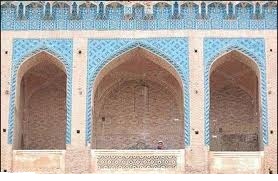 | Picture 9. Turquoise tiled in exterior facade of the building |
 | Picture 10. Turquoise tiled on the surface of the Dome |
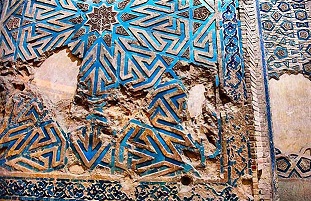 | Picture 11. Range of blue color used on the inner surface of the building |
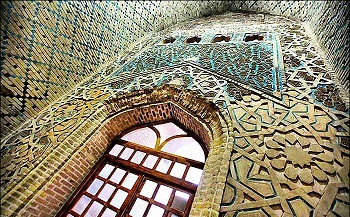 | Picture 12. Yellow, green, and blue colors used in the interior part of the building |
4. Conclusions
- The Iranian-Islamic architecture can be seen as a mirror that keeps the traditional teachings, spirit and divinity of Islamic wisdoms inside itself and is a reflection of artist's spiritual journey who has entered in the realm of mystical insight. In this way, light and color are the spiritual and mystical elements in the Islamic art and architecture that talk about the essence of a unique identity beside the aesthetic function in the space; the Fact that has been hidden behind the veil of material world and pluralities. Light determines the intrinsic identity of artistic work and colors in conjunction with light show the world beyond the visible universe. Light in Islamic art is the symbol of utter existence and unity and color which is produced by light shining is the sign of diversity and diversity's relationship with unity. In this huge building, luminous and colorful architectural spaces have been achieved by artists' hands to such a unity that their effects are a caress on human soul and human guidance from temporal space of the earth to the celestial space of the sky. The penetration of light from the skylights and the side openings of the building; and the presence of decorative motifs such as shamseh, muqarnas, geometric and star shaped are the reflection of real light (God), and the manifestation of Divinity presence and cosmic consciousness which shine inside the human and the man can be thankful to God by getting its help. The usage of azure and blue colors in large range of the building, keeps alive the attaining to the spirituality and the real fact of the meaning in the audience soul and it reminds us the imagination world and the heaven which we have come down. The turquoise color in this building indicates the absolute color of Shiites and it discusses the original and religious identity of founders of this cemetery place.Thus, contrary to the opinion of some scholars and historians of Islamic art who know the devastation of Iranian culture, its monuments and its Islamic spiritual foundations by Mongol invasion; it has to be noted that this negligence compensated in a proper way after this invasion and valuable works based on Iranian culture and Islamic thoughts have been created. So, according above analysis, a building such as soltaniyeh dome is a verity and truth to this claim. Soltaniyeh dome has capabilities and great feature for many researches and it can be examined from different perspectives. Considering to the principles of Shia religious and their reflection in soltaniyeh dome's architecture, and explain the relationship between the concept of inscriptions used in this building and their location, are the recommendations of authors to the researchers who are studying in the field of theoretical studies of Islamic art and architecture.
ACKNOWLEDGEMENTS
- The corresponding author would like to thank Prof. Hassan Bolkhari Qahi to guide and let me use his knowledge to accomplish this article.
Notes
- 1. Eight historians such as Rashidi in Jamee
 believe that Sultan Mohammad is buried in the crypt of building, but twelve historians reject it. [17] 2. It is famous that this building is made as a tomb of shah khodabandeh (sultan mohammad), but it’s completely false; this building had been made as a Jame mosque(Masjed-e Jāmé) and around it there was a dome as a tomb of him which remains now. Natives call it “Chaharsoo” [31].3. For further information About religious, mystical and philosophical Basics of light and color in Islamic art and architecture refer to [12].4. “Allah is the lighter of the heavens and the earth. The example of his light is like a tube, in which there is a wick. The wick is in a lamp and the lamp is as a glittering planet kindled from a blessed tree, an olive that is neither of the east nor of the west. Its oil would almost shine forth though no fire touched it. Light upon light; Allah guides to his light whom he will. Allah strikes parables for people. Allah has knowledge of all things.”[7]5. Muqarnas (Arabic:
believe that Sultan Mohammad is buried in the crypt of building, but twelve historians reject it. [17] 2. It is famous that this building is made as a tomb of shah khodabandeh (sultan mohammad), but it’s completely false; this building had been made as a Jame mosque(Masjed-e Jāmé) and around it there was a dome as a tomb of him which remains now. Natives call it “Chaharsoo” [31].3. For further information About religious, mystical and philosophical Basics of light and color in Islamic art and architecture refer to [12].4. “Allah is the lighter of the heavens and the earth. The example of his light is like a tube, in which there is a wick. The wick is in a lamp and the lamp is as a glittering planet kindled from a blessed tree, an olive that is neither of the east nor of the west. Its oil would almost shine forth though no fire touched it. Light upon light; Allah guides to his light whom he will. Allah strikes parables for people. Allah has knowledge of all things.”[7]5. Muqarnas (Arabic:  Persian:
Persian:  is a type of corbel employed as a decorative device in traditional Islamic and Persian architecture. The related mocárabe refers only to projecting elements that resemble stalactites, elveole.6. Shamse is a kind of sun-shaped or star-shaped design which is used in decorative arts, such as tiled, stucco, carpentry, writing and etc. [32]7. Soltaniyeh building has been designed and decorated during two historical periods which decorative features of each period are different from another. First period 703 to 710 AH, is related to plan of translating the first and the third Shia Imam bodies. In this time we’re seeing the decorations with a focus on tiling and including rectangular and architectural kufi scripts with blue and turquoise tiles. Decorations of second period 710 to 713 AH, possibly related to the time that the plan of translating the Imam bodies failed and prior decorations have been covered by plaster. They are including inscriptions and other beautiful designs [16].8. Here, the basis of our interpretation is some verses of Qur'an which are referred to guiding role of stars for human beings: “it is he who has created for you the stars, so that you can be guided by them in the darkness of land and sea. We have made plain our verses to a nation who knows.”[7]9. Put the name of Ali (AS), along with Mohammad, in Shamsehes and decorations of this place can be known as a sign of Sultan Mohammad devotion to the Shia religious.10. “Plato knows the circle as an allegory of all the existence that not only starts from Unit but also terminates to Him. [12] According to this topic, in a different interpretation it can be said that the use of circle in this place is emphasis on Pantheism and absolute integrity of one which everything are His manifestation and everything in circle of existence are terminated to His sacred essence. “He is the first and the last, the clear and the hidden. He has knowledge of all things.”[7] 11. Basically, Ilkhani races used glazed tiles instead of using brick in the internal decoration of buildings and for this reason, the use of color expanded in the Iranian architecture of that era. New colors such as saffron and green were chosen, and mosaic tiles with floral, geometric and calligraphic decoration widely used by artists. The use of design and color in this period was indebted to Quran illumination. [33]
is a type of corbel employed as a decorative device in traditional Islamic and Persian architecture. The related mocárabe refers only to projecting elements that resemble stalactites, elveole.6. Shamse is a kind of sun-shaped or star-shaped design which is used in decorative arts, such as tiled, stucco, carpentry, writing and etc. [32]7. Soltaniyeh building has been designed and decorated during two historical periods which decorative features of each period are different from another. First period 703 to 710 AH, is related to plan of translating the first and the third Shia Imam bodies. In this time we’re seeing the decorations with a focus on tiling and including rectangular and architectural kufi scripts with blue and turquoise tiles. Decorations of second period 710 to 713 AH, possibly related to the time that the plan of translating the Imam bodies failed and prior decorations have been covered by plaster. They are including inscriptions and other beautiful designs [16].8. Here, the basis of our interpretation is some verses of Qur'an which are referred to guiding role of stars for human beings: “it is he who has created for you the stars, so that you can be guided by them in the darkness of land and sea. We have made plain our verses to a nation who knows.”[7]9. Put the name of Ali (AS), along with Mohammad, in Shamsehes and decorations of this place can be known as a sign of Sultan Mohammad devotion to the Shia religious.10. “Plato knows the circle as an allegory of all the existence that not only starts from Unit but also terminates to Him. [12] According to this topic, in a different interpretation it can be said that the use of circle in this place is emphasis on Pantheism and absolute integrity of one which everything are His manifestation and everything in circle of existence are terminated to His sacred essence. “He is the first and the last, the clear and the hidden. He has knowledge of all things.”[7] 11. Basically, Ilkhani races used glazed tiles instead of using brick in the internal decoration of buildings and for this reason, the use of color expanded in the Iranian architecture of that era. New colors such as saffron and green were chosen, and mosaic tiles with floral, geometric and calligraphic decoration widely used by artists. The use of design and color in this period was indebted to Quran illumination. [33] Abstract
Abstract Reference
Reference Full-Text PDF
Full-Text PDF Full-text HTML
Full-text HTML